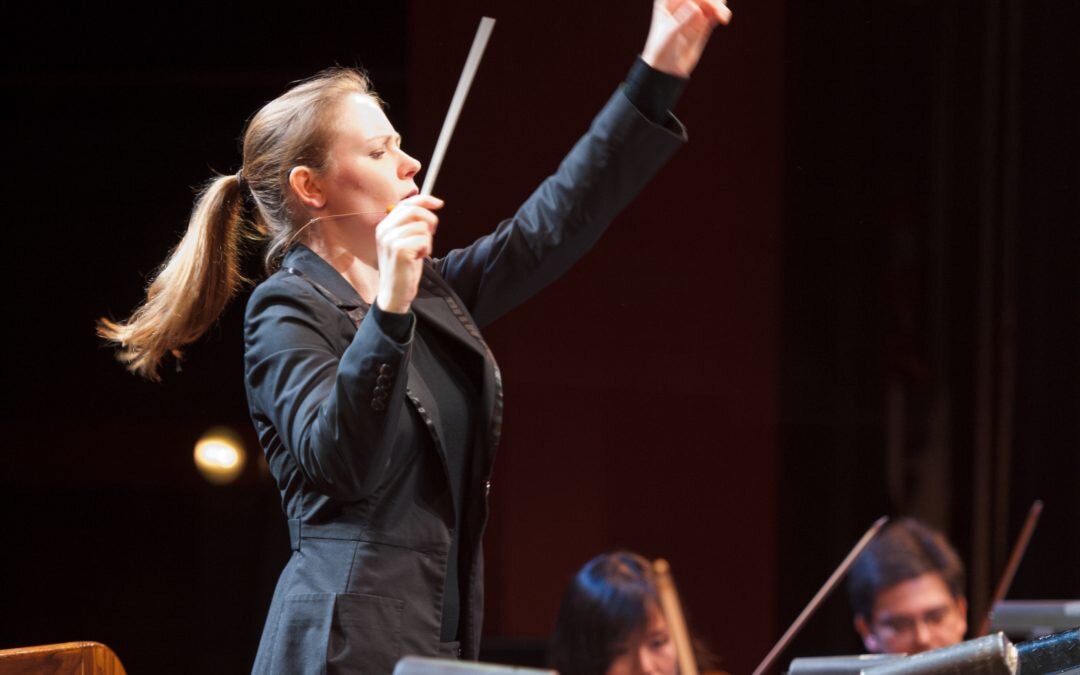Praise for Gemma New and the Toronto Symphony
Gemma New performed with the Toronto Symphony (Photocredit: Fred Stucker)
Toronto Symphony Goes In Pistols Blazing With Gemma New
By Stephan Bonfield
Ludwig Van Toronto
March 10, 2019
Shostakovich’s Fifth Symphony may be one of the most performed in the genre of the 20th century, but it is also surely the most misunderstood. When New Zealand-born conductor Gemma New, who is Music Director of the Hamilton Philharmonic Orchestra, took the reins of the Toronto Symphony Orchestra last night to conduct it, she also took on the unenviable task of confronting the many-worlds view of how to interpret the work without falling into ambiguous territory.
Happily, New resisted some of the non-descript approaches we often hear many conductors taking with the work, but even better, she didn’t cave in to pat answers either and denied giving us a Fifth of mindless optimism. But more on all that later.
Also on the program was the popular Mozart Concerto for Flute, Harp and Orchestra, premiered in 1778 during one of Mozart’s stays in Paris. Essentially a sinfonia concertante, an elegant and very popular chamber medium in Paris at the time, the work is considered light listening fare. That is a shame: often ignored are the interpretively challenging parts for both solo instruments, which were handled with uncommon spectral mastery by Heidi Van Hoesen Gorton, the TSO’s Principal Harp, and Kelly Zimba, TSO principal flute.
Considering that the chamber work is written for a small acoustic, Gemma New’s slower, spacious opening-tempo Allegro proved felicitous in cavernous Roy Thomson Hall for creating stellar moments of harmonic, interactive blend. The performance was often sublime, so warm and clear, bright with Parisian effect and flushed with richly-toned sensibility, that by the end of the three movements there could be no doubt the two soloists and TSO ensemble had pulled off a definitive musical highlight of the entire season.
Frankly, I don’t think I want to hear Mozart’s Concerto for Flute and Harp again unless it is played at least as well as what we heard, i.e., not treated as pop music, but approached with an understanding of what Mozart was trying to do with this rare combination of instruments. How lucky we were to hear this performance.
Shostakovich began a new phase of hidden radical commentary with the Fifth, a work muffled with the agonies of a people trapped inside a world so repugnant that the only way for the composer to stay alive was by disguising artistic motive and intent. In effect, Shostakovich was forced to move underground in order to create a seditious art of bitter irony.
The TSO put it all on unsparing display. The second movement’s satire of a march and trio is a send-up of government and military ostentation; the third, a tearful elegy for all those taken away — no one missed that connection at the first-ever performance. In fact, many wept, as has often been reported.
And the finale, packed with references to an earlier song he wrote titled “Vozrozhdenije” (Resurrection/rebirth) and the traditional sounds associated with “panikhida” or what is called the Russian Orthodox Requiem, was as moving as it was jarring under Gemma New’s passionate baton.
And here we come to Gemma New’s rather interesting solution to a problem most conductors don’t really want to confront. How do you deal with these violent opposing forces in a symphony that carries so much forceful commentary in every one of its notes, bars and phrases?
The conventional answer is to ignore the problems and take the work as a kind of darkness-to-light journey, but that hasn’t really worked in the face of overwhelming evidence to the contrary, given what seems to be lodged in the score’s embittered motives and harmonies.
But, New finds a different way, and it works. She emphasizes the tragedy of the score but leaves the ending to sound more like an open question, neither triumphant nor bitterly ironic. Is it a rebirth or a forced rejoicing under one of the cruellest autocrats the twentieth century had ever known? She turns Shostakovich Fifth into The Unanswered Question, and on an existential level, the TSO makes this work extremely well.
In the end, New lets you decide the symphony’s meaning for yourself, even while allowing the timpani section to pound out its own triple forte grotesquerie during those hit-you-over-the-head final bars. It’s brilliant, and instead of leaving me in the darkest depression, as the work inevitably has done repeatedly, the TSO performance allowed me to see that the music’s ineffable complexity can run along so many emotional directions that we cannot accept that any one interpretive message is the only truth the work can offer.
Gemma New and the TSO brought the Shostakovich Fifth to life in a way that committed wholly to the score without descending into shrill contemporary political statements. Her canny approach will induce more audiences to have emotionally vibrant realizations about this magnificent work when she conducts it again in her meteoric career.
You can read the full article here.

